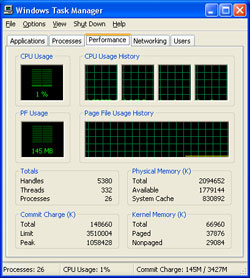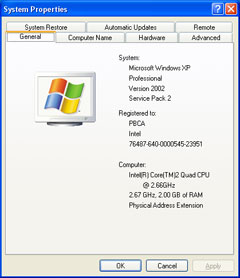Quad Cores: Intel Kentsfield Preview
by Anand Lal Shimpi on September 28, 2006 7:00 PM EST- Posted in
- CPUs
At this year's Spring IDF, before the launch of Intel's new Core 2 processors, in an unprecedented move (for Intel) we were allowed to benchmark the new Core 2 processor alongside an AMD system and publish benchmarks. While we've previewed Intel processors in the past before their launch, this was the first time we were able to test something this far in advance of its launch, with Intel's support, and also test a competing AMD part at Intel's own show. Previously, Intel would hardly even recognize that it had a competitor, but in the past year alone Intel's attitude towards competition has changed dramatically. The change in heart was also quite evident at this year's Fall IDF, where featuring competing AMD solutions on stage for performance comparisons was far from taboo.
Generally speaking, Intel had a lot of success with its early previews of the Core 2 processors. Readers could get a good idea of performance well before its launch and they could plan upgrades accordingly, and as it turned out, the final shipping performance of Core 2 CPUs was nothing short of impressive. With the November launch of its quad-core Kentsfield and Clovertown based processors quickly approaching, Intel offered members of the press a similar chance to take an early look at quad-core performance at IDF.
This time around there were only two systems, both of which were Intel based. There's no need for a reference AMD system since we've already determined that Intel's Core 2 Extreme processor is faster than anything AMD currently has to offer; what we're now interested in is how much of a performance improvement you can get from going to quad-core. Both systems were identically configured with 2GB of DDR2-800 running at 4-4-4-12 timings on an Intel BadAxe2 motherboard based on the 975X chipset.
Unfortunately, we weren't very pleased with the benchmarking circumstances this time around. When we tested Core 2 at last IDF, we were able to run some of our own benchmarks and the benchmarks represented a reasonable subset of the performance tests we were already running in house. With Intel's quad-core setup, we were not able to run any of our own benchmarks and the majority of the tests we were able to run were of benchmarks we wouldn't normally use to begin with. While we could adjust settings and use some of our own demos/test configurations last time, this time we couldn't do anything other than click go and see the results generated in real time. There's no reason to believe that Intel did anything fishy, and the performance we saw agreed with internal performance testing of Kentsfield, but overall the time benchmarking at IDF was not all that useful.
Keep in mind that the benchmarks Intel selected to show off were specifically chosen to maximize the impact of four cores, and thus we're looking at a lot of significantly multi-threaded applications like 3dsmax. Realistically, the majority of tests in our normal CPU benchmark suite will not see a benefit from quad-core and thus the real purchase decision between dual and quad core is far more difficult to make than you'd think based on these numbers alone. At the same time, when your options at $999 are a 2.93GHz Core 2 Extreme X6800 (dual-core) or a 2.66GHz Core 2 Extreme QX6700, we'd generally recommend going for the latter if you're multitasking at all or plan on running any applications that are well threaded. Even games like Alan Wake and Unreal Tournament 2007 will be able to take advantage of the extra cores, and you can always overclock the processor to make up for the clock speed difference, but you can't enable more cores than you have.
With the stage set, let's take a look at the actual performance Kentsfield brings to the table.
Generally speaking, Intel had a lot of success with its early previews of the Core 2 processors. Readers could get a good idea of performance well before its launch and they could plan upgrades accordingly, and as it turned out, the final shipping performance of Core 2 CPUs was nothing short of impressive. With the November launch of its quad-core Kentsfield and Clovertown based processors quickly approaching, Intel offered members of the press a similar chance to take an early look at quad-core performance at IDF.
This time around there were only two systems, both of which were Intel based. There's no need for a reference AMD system since we've already determined that Intel's Core 2 Extreme processor is faster than anything AMD currently has to offer; what we're now interested in is how much of a performance improvement you can get from going to quad-core. Both systems were identically configured with 2GB of DDR2-800 running at 4-4-4-12 timings on an Intel BadAxe2 motherboard based on the 975X chipset.
 |
 |
| Click to enlarge | |
Unfortunately, we weren't very pleased with the benchmarking circumstances this time around. When we tested Core 2 at last IDF, we were able to run some of our own benchmarks and the benchmarks represented a reasonable subset of the performance tests we were already running in house. With Intel's quad-core setup, we were not able to run any of our own benchmarks and the majority of the tests we were able to run were of benchmarks we wouldn't normally use to begin with. While we could adjust settings and use some of our own demos/test configurations last time, this time we couldn't do anything other than click go and see the results generated in real time. There's no reason to believe that Intel did anything fishy, and the performance we saw agreed with internal performance testing of Kentsfield, but overall the time benchmarking at IDF was not all that useful.
Keep in mind that the benchmarks Intel selected to show off were specifically chosen to maximize the impact of four cores, and thus we're looking at a lot of significantly multi-threaded applications like 3dsmax. Realistically, the majority of tests in our normal CPU benchmark suite will not see a benefit from quad-core and thus the real purchase decision between dual and quad core is far more difficult to make than you'd think based on these numbers alone. At the same time, when your options at $999 are a 2.93GHz Core 2 Extreme X6800 (dual-core) or a 2.66GHz Core 2 Extreme QX6700, we'd generally recommend going for the latter if you're multitasking at all or plan on running any applications that are well threaded. Even games like Alan Wake and Unreal Tournament 2007 will be able to take advantage of the extra cores, and you can always overclock the processor to make up for the clock speed difference, but you can't enable more cores than you have.
With the stage set, let's take a look at the actual performance Kentsfield brings to the table.










34 Comments
View All Comments
kleinwl - Thursday, September 28, 2006 - link
I for one am extremely excited about quad core. If the pricing stays relatively neutral to the core 2 dual units (minus a speed bump or two) these cores could become mainstream very quickly. If they do become mainstream, similar to how Pentium D and core 2 units are, I expect that we will see a push for more software developers to take advantage of them, at which point they will be much more useful than a mere dual or single core.There are many ways that we can take advantage of quad cores now... for example, distributed computing, power multi-tasking (ripping DVD/CDs while watching a movie and playing WoW), or just offloading physics to the unused cores. Even if these are normally idle, the ability to run 4 things at one is a huge advantage when things are time critical(ie. I need to finish so my wife so she can check her email).
Anyway, I feel like I'm stuck in the stone age now with my (still respectable) venice 3000+. Even overclocked to 2.3GHz, the computer feels slower that my brother's core 2 duo lappy.
kmmatney - Thursday, September 28, 2006 - link
I think that offloading the physics onto another core will be the next big thing, so I think at least dual core will be best to get the best experience out of the next generation of games. All of the gaming consoles are multicore, so games will naturally start to use all cores on a PC.coldpower27 - Friday, September 29, 2006 - link
I rather have a discrete PPU for that, like the AEGIA thingy, rather then the general purpose Quad Core do it, the CPU should be dedicated to other things like AI.JarredWalton - Friday, September 29, 2006 - link
I too would rather have a $275 add-in card instead of getting something just as powerful (possibly more so) as part of the CPU. I would much rather spend $1000 for 2.93 GHz and two cores than $1000 for 2.67 GHz and four cores.... (Sarcasm intended)Long term, I expect PPU-type cores and even GPU cores to make their way into the CPU package. GPUs have an issue, though, as they demand tons of bandwidth and lots of memory that they have essentially exclusive access to. But by 2010 I'm almost certain we will have new cores in the CPU. Or maybe Intel will just make SSE6 or whatever a full physics specification, and then state that there are only x number of Physics pipelines per CPU package?
coldpower27 - Saturday, September 30, 2006 - link
I am not sure where you are going with this. I don't see the general purpose processor with the CPU being more powerful then the dedicated PPU for awhile, I am much for specialized processors with a specific purpose and let the general purpose processor handle something else. If they can make the Physics run on CPU faster then a dedicated unit can do it, then ok, do physics on the CPU.Sorry my sarcasm detection is broekn today, so just to say, I would prefer a lower clock Kentsfield over a slightly higher clocked Core 2 Duo (Conroe), given if the pricing is the same.
Maybe we will have an integrated, platform with the CPU/GPU/PPU functions all integrated together. However I like the ability to upgrade each piece of the puzzle rathern then being forced to upgrade the single "processor" all at once.
theteamaqua - Thursday, September 28, 2006 - link
as a gamer i would say this thing is uselessbrownba - Friday, September 29, 2006 - link
as an intelligent person, I would say your comments are useless.
wilki24 - Friday, September 29, 2006 - link
Useless for gaming? Hardly.http://www.siliconvalleysleuth.com/2006/09/intel_s...">IDF Alan Wake Demo
Notice the water? The lighting? The phsyics when the tornado rips apart those buildings?
Try utterly necassary for gaming. :-)
Griswold - Friday, September 29, 2006 - link
You are certainly easily convinced by marketing yip-yap. I'm all for multicore systems, but before I believe that you absolutely need 4 cores for this kind of visuals, I want to see a process- and load logfile of the 4 cores.Quite frankly, 80% of the eye candy seen in that movie is done by the GPU and not by the CPU - considering all the whining from game developers about multithreading games, I find it hard to believe that streaming/threading a game on 4 cores will work so much better than doing the same on for 2 cores. In fact, I'm willing to bet, the exact same stuff is doable on a dual core machine without a noticeable performance hit.
Questar - Friday, September 29, 2006 - link
Which game developer did you say you worked for?